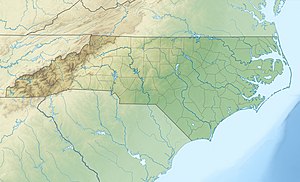Service Creek (Haw River tributary)
Appearance
| Service Creek Tributary to Haw River | |
|---|---|
| Location | |
| Country | United States |
| State | North Carolina |
| County | Alamance |
| Physical characteristics | |
| Source | divide between Service Creek and Little Alamance Creek |
| • location | pond at Glen Raven, North Carolina |
| • coordinates | 36°06′51″N 079°28′15″W / 36.11417°N 79.47083°W[1] |
| • elevation | 690 ft (210 m)[2] |
| Mouth | Haw River |
• location | about 0.25 miles east of Burlington, North Carolina |
• coordinates | 36°06′32″N 079°23′35″W / 36.10889°N 79.39306°W[1] |
• elevation | 499 ft (152 m)[1] |
| Length | 5.93 mi (9.54 km)[3] |
| Basin size | 8.01 square miles (20.7 km2)[4] |
| Discharge | |
| • location | Haw River |
| • average | 9.10 cu ft/s (0.258 m3/s) at mouth with Haw River[4] |
| Basin features | |
| Progression | Haw River → Cape Fear River → Atlantic Ocean |
| River system | Haw River |
| Tributaries | |
| • left | unnamed tributaries |
| • right | Staley Creek |
| Bridges | Durham Street, Burch Bridge Road, Lakeside Avenue Ext, Glencoe Road, Lower Hopedale Road, Apple Street, North Graham-Hopedale Road, Squaw Valley Trail |
Service Creek is a 5.93 mi (9.54 km) long 2nd order tributary to the Haw River, in Alamance County, North Carolina.
Course
[edit]Service Creek rises in a pond at Glen Raven in Alamance County and then flows northeast and makes a turn southeast to the Haw River about 0.25 miles east of Burlington, North Carolina.[2]
Watershed
[edit]Service Creek drains 8.01 square miles (20.7 km2) of area, receives about 45.8 in/year of precipitation, and has a wetness index of 432.18 and is about 13% forested.[4]
See also
[edit]References
[edit]- ^ a b c "GNIS Detail - Service Creek". geonames.usgs.gov. US Geological Survey. Retrieved 5 October 2019.
- ^ a b "Back Creek Topo Map, Alamance County NC (Mebane Area)". TopoZone. Locality, LLC. Retrieved 4 October 2019.
- ^ "ArcGIS Web Application". epa.maps.arcgis.com. US EPA. Retrieved 5 October 2019.
- ^ a b c "Service Creek Watershed Report". Waters Geoviewer. US EPA. Retrieved 5 October 2019.


